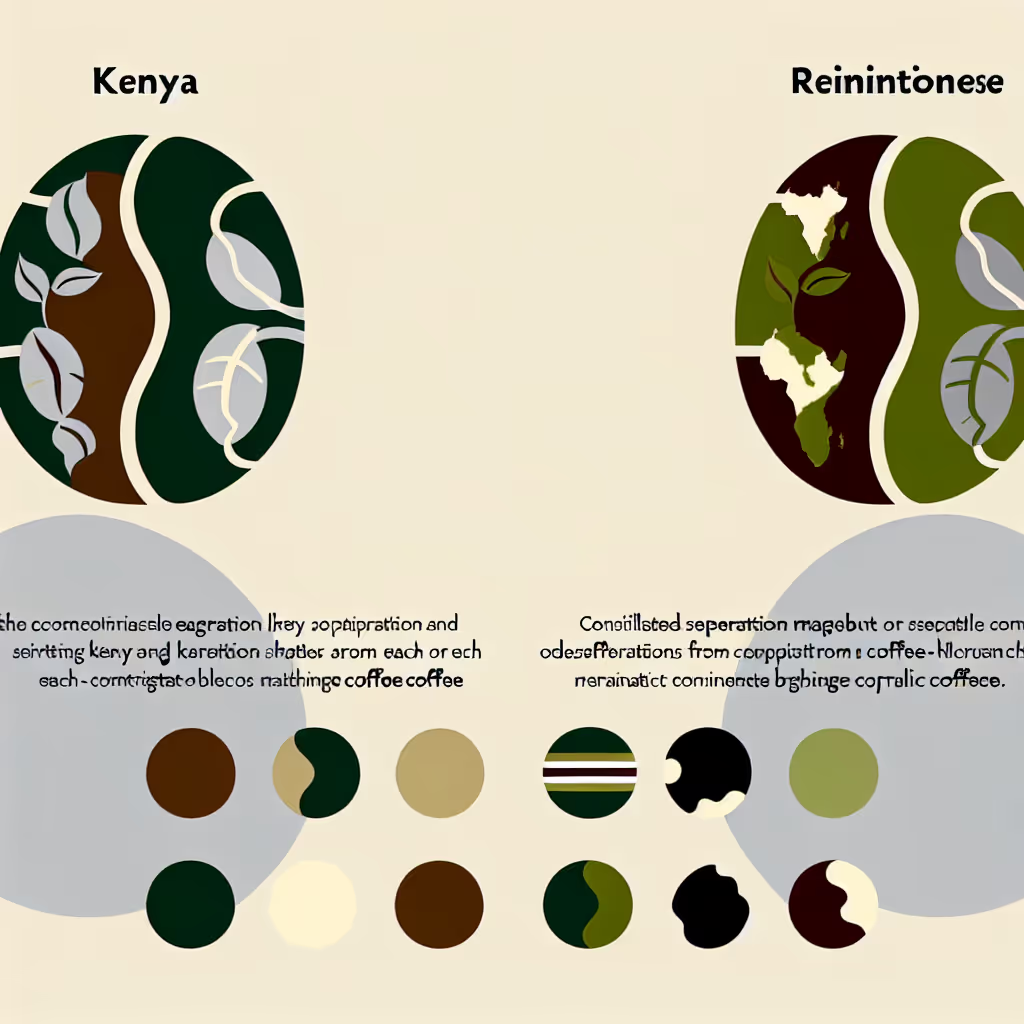Kenyan Vs. Nepalese Coffee
This comparison explores the distinct qualities of Kenyan and Nepalese coffee, highlighting their unique flavor profiles, growing conditions, and brewing methods to help coffee enthusiasts make informed choices.

Brief Description
Kenyan coffee is renowned for its bright acidity, full body, and complex flavor profile. Grown in the rich volcanic soils of the Central Highlands, these beans benefit from ideal climate conditions and meticulous processing. The result is a cup that's bold, wine-like, and often described as the 'connoisseur's choice'. With notes ranging from blackcurrant to citrus, Kenyan coffee offers a truly unique and memorable tasting experience.
Nepalese coffee is a hidden gem in the world of specialty coffee. Grown in the pristine Himalayan foothills, these beans benefit from unique microclimates and rich soil. The result is a complex, full-bodied coffee with bright acidity and distinctive flavor notes. Despite being a relatively new player in the global coffee scene, Nepal is quickly gaining recognition for its high-quality, sustainably-produced beans that offer a taste of the Himalayas in every cup.
Importance of Comparison
Comparing Kenyan and Nepalese coffee is crucial for coffee lovers seeking to expand their palate beyond mainstream origins. These two regions offer unique flavor profiles and growing conditions that contribute to exceptional cups. Understanding their differences helps consumers make informed decisions, whether they're looking for a bold, wine-like Kenyan brew or a complex, Himalayan-influenced Nepalese coffee experience.
Key Attributes
Origin
Kenyan
Nepalese


Consumer Guide
When choosing between Kenyan and Nepalese coffee, consider your flavor preferences. Kenyan coffee is known for its bright acidity and bold flavors, with notes of blackcurrant and citrus. It's ideal for those who enjoy a full-bodied, complex cup. Nepalese coffee offers a more subtle complexity with floral and nutty notes, perfect for those seeking a unique, balanced flavor. For brewing, both origins excel in pour-over and French press methods. Kenyan beans are particularly good for cold brew, while Nepalese beans work well in espresso. Consider the processing method: Kenyan coffee often undergoes double fermentation, while Nepalese coffee offers a variety of processing options, including natural and honey methods. Lastly, think about sustainability and production scale: Kenyan coffee has a larger annual production, while Nepalese coffee is a more exclusive, small-scale product.
Expert Opinions
Coffee expert James Hoffmann notes, 'Kenyan coffee often represents the pinnacle of brightness and complexity in the cup, while Nepalese coffee is an exciting new frontier in specialty coffee.' Barista champion Emi Fukahori adds, 'Nepalese coffee surprises with its clean cup and unique terroir influence, offering a refreshing alternative to more established origins like Kenya.' Both experts agree that these origins represent excellent choices for coffee enthusiasts looking to explore diverse flavor profiles and support sustainable farming practices.
FAQs
Kenyan coffee is known for its bright acidity, full body, and complex flavors including blackcurrant, citrus, and floral notes. Nepalese coffee offers a more subtle complexity with citrus, floral, and nutty flavors, reflecting its unique Himalayan terroir.
Kenyan coffee is grown in the volcanic soils of the Central Highlands at altitudes of 1400-2100m. Nepalese coffee is cultivated in the Himalayan foothills at 1000-2000m, benefiting from unique microclimates. Both regions offer ideal conditions for high-quality coffee production, but with distinct environmental influences.
Both Kenyan and Nepalese coffees excel in pour-over and French press methods. Kenyan coffee is particularly good for cold brew due to its bold flavors, while Nepalese coffee works well in espresso. Experiment with different methods to find your preferred way of highlighting each origin's unique characteristics.
Kenya has a much larger coffee production, with an annual output of around 50,000 metric tons. Nepal's coffee industry is smaller and newer, producing about 530 metric tons annually. This makes Nepalese coffee a more exclusive and potentially harder-to-find option compared to the more widely available Kenyan beans.
Kenyan coffee is typically washed and often undergoes a unique double fermentation process before being sun-dried. Nepalese coffee offers more variety in processing, including washed, natural, and honey methods. These different processes contribute to the distinct flavor profiles of each origin.
Both origins offer unique experiences for coffee enthusiasts. Kenyan coffee is ideal for those seeking a bold, complex cup with distinctive acidity. Nepalese coffee is perfect for adventurous drinkers looking to explore an emerging origin with subtle, nuanced flavors influenced by its Himalayan terroir. Try both to expand your coffee palate and discover new favorite flavors.
Conclusion
Kenyan and Nepalese coffees offer distinct and rewarding experiences for coffee enthusiasts. Kenyan beans are celebrated for their bright acidity, full body, and complex flavors, making them a favorite among connoisseurs. Nepalese coffee, while lesser-known, is rapidly gaining recognition for its unique Himalayan-influenced profile and sustainable production practices. Both origins excel in various brewing methods and offer opportunities to support diverse coffee-growing communities. Whether you prefer the bold, wine-like qualities of Kenyan coffee or the subtle complexity of Nepalese beans, exploring these origins will undoubtedly enrich your coffee journey and broaden your appreciation for single-origin coffees.






